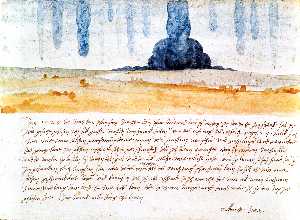- Opera d'arte
- Artista
- Opere simili
- Acquista la riproduzione
- Acquista immagine
- Valutazione
- Dipinto dalla foto
Artista: Albrecht Durer
Temi: Ritratti
Data: 1493
Formato: 57 x 45 cm
Museo: Musée du Louvre (Paris, France)
Temi: olio
ritratto dell'artista in possesso di un cardo ( o eryngium ) è un dipinto ad olio su pergamena incollato su tela dall'artista tedesco albrecht dürer , dipinto in 1493 . È il primo di Dürer's dipinto self-portraits ed è stato identificato come uno dei primi self-portraits dipinto da un artista nordico . L'appuntamento , e la pianta nel artist's mano , sembra suggerire che si tratti di un ritratto di fidanzamento ( Brautporträt ) . Dürer si è infatti raffigurato nell'atto di offrire uno spray fiorito identificato dai botanici come eritio ametista : il suo nome tedesco è " Mannestreue " , che significa fedeltà coniugale . Simile al cardo ( da cui il portrait's titolo ) , questa pianta umbellifera è usata in medicina , ed è considerato un afrodisiaco . Potrebbe anche avere un significato religioso ; la stessa pianta in forma di contorno è iscritta nella terra d'oro di Dürer's dipingere cristo come l'uomo dei dolori ( 1493–94 ) .
Artista |
|
|---|---|
Download |
|
Permessi |
Gratuito per uso non commerciale. Vedi sotto. |
Albrecht Durer – Opere d'arte più viste
|
This image (or other media file) is in the public domain because its copyright has expired. However - you may not use this image for commercial purposes and you may not alter the image or remove the watermark. This applies to the United States, Canada, the European Union and those countries with a copyright term of life of the author plus 70 years.
|















 Note that a few countries have copyright terms longer than 70 years: Mexico has 100 years, Colombia has 80 years, and Guatemala and Samoa have 75 years. This image may
not be in the public domain in these countries, which moreover do not implement the
Note that a few countries have copyright terms longer than 70 years: Mexico has 100 years, Colombia has 80 years, and Guatemala and Samoa have 75 years. This image may
not be in the public domain in these countries, which moreover do not implement the